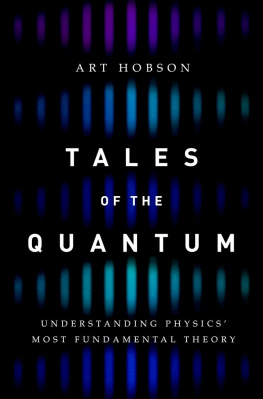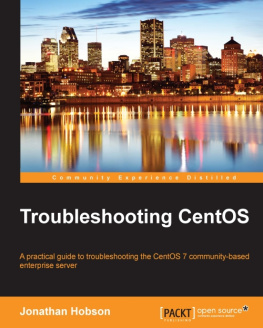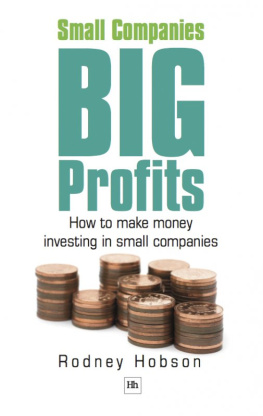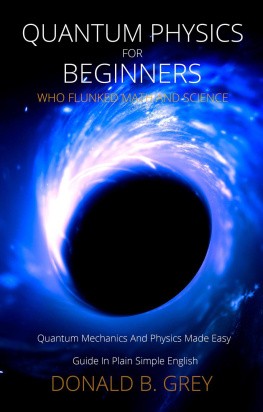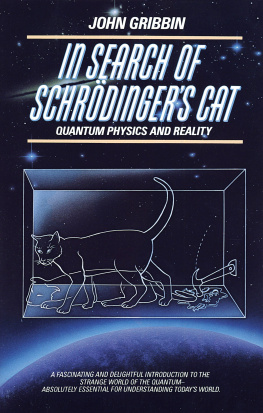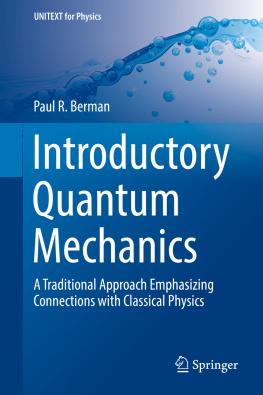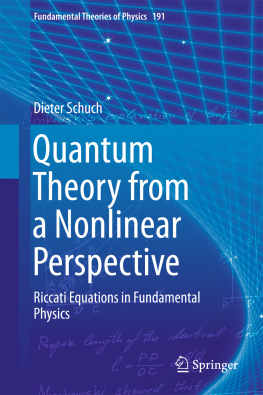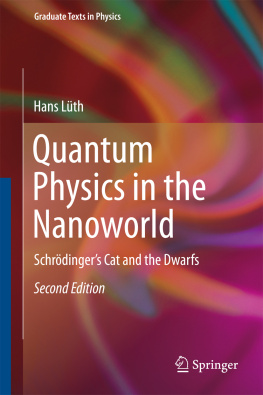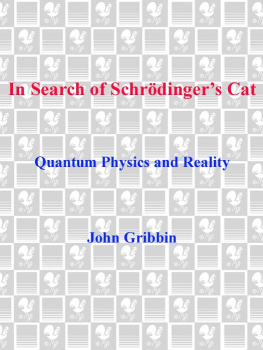Tales of the Quantum

Oxford University Press is a department of the University of Oxford. It furthers the Universitys objective of excellence in research, scholarship, and education by publishing worldwide. Oxford is a registered trade mark of Oxford University Press in the UK and certain other countries.
Published in the United States of America by Oxford University Press
198 Madison Avenue, New York, NY 10016, United States of America.
Oxford University Press 2017
All rights reserved. No part of this publication may be reproduced, stored in a retrieval system, or transmitted, in any form or by any means, without the prior permission in writing of Oxford University Press, or as expressly permitted by law, by license, or under terms agreed with the appropriate reproduction rights organization. Inquiries concerning reproduction outside the scope of the above should be sent to the Rights Department, Oxford University Press, at the address above.
You must not circulate this work in any other form and you must impose this same condition on any acquirer.
Library of Congress Cataloging-in-Publication Data
Names: Hobson, Art, 1934 author.
Title: Tales of the quantum : understanding physics most fundamental theory / Art Hobson.
Description: New York, NY : Oxford University Press, [2017] | Includes bibliographical references and index.
Identifiers: LCCN 2016018154 | ISBN 9780190679637 | ISBN 0199384223 | eISBN 9780199384242
Subjects: LCSH: Quantum theory.
Classification: LCC QC174.12 .H53 2016 | DDC 530.12dc23
LC record available at https://lccn.loc.gov/2016018154
Also by Art Hobson
Concepts in Statistical Mechanics
Physics and Human Affairs
The Future of Land-Based Strategic Missiles (co-editor, co-author)
Physics: Concepts & Connections
For my brother Richard Hobson
CONTENTS
Table
From Dr. Suess to the Hardy Boys to Tom Sawyer, the tales told in books were my most dependable boyhood buddies. I first encountered physics many years later, following a degree in music and a stint in the Army. As a student of physics at Kansas State University in Manhattan, I was delighted to find much of what I learned in textbooks and lectures to be fascinating, often strange, and always mind-expanding, stories. But now they were true stories, about a natural world that increasingly intrigued me. An account of the forces acting on an airplane, an elegant proof that Earth follows an elliptical path around the sun, or an account of the famous experiment demonstrating that light is a waveall were fascinating adventures of the mind. Fifty-five years later, my love affair with nature persists.
This book tells tales of our quantum universe, in words accessible to everyone, without mathematics or unnecessary technicalities. My protagonist is the quantum, arguably the central actor on the cosmic stage. Although most popular books about quantum physics follow the subjects history, Tales of the Quantum follows the phenomena: waveparticle duality, fundamental randomness, being in two places at once, and quantum jumps, to name a few. It presents history and people only to the extent that they illuminate the phenomena. Nevertheless, I hope Tales of the Quantum has a storylike quality that will be meaningful to both nonscientists and scientists. Its written for all who would like to better fathom, before they depart this mortal coil, what makes the universe tick.
Tales of the Quantum has a central message: quantum physics is fine and healthy just as it is. From the 1920s through today, the radical nature of the theory has prompted many, including Albert Einstein, to find fault with one or the other fundamental quantum precept and to try to fix it. But quantum physics doesnt need fixing. The theory may be strange, but its not a mystery. Well discover that all its supposed paradoxes are resolvable and can be explained consistently in ordinary English without invoking algebra, technicalities, or supernatural powers.
. In my view, measurement remains the only significant quantum foundational issue still in dispute. Regarded by some as unresolved, by others as resolved, and by still others as a mere pseudo-problem that needs no resolution, the problem splits the experts and is compounded by its title. By calling it the measurement problem, we suggest that quantum foundations have something to do with the human beings who make scientific measurements, leading some to conclude that quantum physics reinstates human minds at the center of physics for the first time since Copernicus. Its even been seriously suggested that human consciousness is required for normal physical reality to emerge from the quantum world.
The work of Wojciech Zurek and many others, although not entirely solving the measurement problem, has clarified that measurements are indeed crucial to understanding how quantum physics leads to the world of our experience. But these so-called measurements have nothing necessarily to do with humans; they are conducted constantly, all over the universe, by the environment. Human consciousness has no essential role in the foundations of quantum physics.
Another distinctive facet is this books take on the famous issue of waveparticle duality. Is the universe made of waves in spatially extended fields, or of tiny particles, or both? As the title of my 2013 American Journal of Physics article states, there are no particles, there are only fields. The universe is made entirely of fields, such as Earths gravitational field and the magnetic fields youve probably experienced when playing with magnets. With the notable exception of Richard Feynman, most quantum field theoristsphysicists who integrate quantum physics with Einsteins theory of relativityhave taken this viewpoint, but somehow it hasnt filtered through to the broader ranks of physicists, other scientists, and the public.
Tales of the Quantum contains no mathematics beyond a few numbers. Mathematical physicist Paul Dirac stated, Mathematics is only a tool and one should learn to hold the physical ideas in ones mind without reference to the mathematical form.for the Ultimate Theory (W. W. Norton & Company, 1999), and Louisa Gilders The Age of Entanglement: When Quantum Physics Was Reborn (Alfred A. Knopf, 2008), illustrate that one can explain physics, including quantum physics, accurately and nontechnically.
In aiming for a book that is suitable for both nonscientists and scientists, I have relegated many details to numbered endnotes that provide additional commentary, supporting references, and some more technical discussion. These endnotes can be safely omitted without disturbing the flow of the text. There is also an extensive glossary.
At least since the days of the early Greeks, philosophical people have wanted to know the ultimate constituents of the universe. What is the stuff of reality and how does it behave? One popular answer, that its made of atoms, is outdated and incorrect. Weve known for a few decades that most of the universe is actually not made of the chemical atoms. However, atoms and everything else are made of things more fundamental and even more intriguing than atoms, namely fields that are bundled into quanta. This book proceeds from these two key concepts, fields and quanta. They take getting used to, but you can grasp them. The quantum, like an eccentric friend, requires a modicum of time to be understood.

